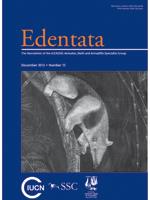Giant armadillos (Priodontes maximus) are one of the most endangered mammals in the Gran Chaco. They are largely nocturnal, highly fossorial and solitary, characteristics that have limited the understanding of their behavior and ecology. We report on the results of a study of the structure of 32 giant armadillo burrows in 25,000 ha of semi-arid forest owned by Toba aborigines of Formosa, Argentina. Burrow entrances were on average 43 cm wide and 36 cm high and more likely to be facing west (24) than east (8).
Los tatú carreta (Priodontes maximus) son uno de los mamíferos en mayor peligro de extinción del Gran Chaco. Son animales principalmente nocturnos, fosoriales y solitarios, características que han limitado el conocimiento sobre su comportamiento y ecología. Presentamos en este trabajo los resultados de un estudio para caracterizar la estructura de 32 cuevas de tatú carreta en 25,000 ha de bosques semi-áridos propiedad de comunidades Toba de Formosa, Argentina. Las entradas de las cuevas eran, en promedio, de 43 cm de ancho y 36 cm de alto, y estaban más frecuentemente orientadas hacia el oeste (24) que hacia el este (8).
Giant armadillos are the largest of the armadillos, with a head-to-body length of approximately 89 cm and an average adult body mass of 30–40 kg (Redford & Eisenberg, 1992; Meritt, 2008). They range over most of South America, from Colombia and northern Venezuela to Paraguay and northern Argentina (Silveira et al., 2009; Srbek-Araujo et al., 2009; Abba & Superina, 2010; Torres & Jayat, 2010). They are found in the tropical forests of Amazonia, as well as in the open savannas of the Cerrado and Gran Chaco. The species has been classified as Vulnerable at the global level by the IUCN Red List of Threatened Species (Superina & Abba, 2010) and in Argentina its populations are threatened with extinction due to hunting and habitat destruction (Porini, 2001).
Giant armadillos are rarely seen because they are largely nocturnal, highly fossorial and solitary animals (Carter, 1983; Carter & Encarnação, 1983; Redford & Eisenberg, 1992; Vizcaíno & Milne, 2002; Cuéllar & Noss, 2003; Noss et al., 2004). They are extremely powerful diggers that dig for food (mainly ants and termites) and refuge (Carter & Encarnação, 1983; Redford & Eisenberg, 1992).
We report here information on the size and orientation of giant armadillo burrow entrances found in 25,000 ha of semi-arid forest owned by 12 Toba communities in Formosa Province, Argentina. The area is part of the semiarid Argentinean Chaco (61°–62°W, 23.5°–23.7°S), which is characterized by low xeric vegetation, patches of thorny bushes, bromeliads, and cacti (Morello & Hortt, 1987; Adámoli et al., 1990).
FIGURE1.
Compass orientation of 32 giant armadillo burrows. The average orientation is indicated with a black solid arrow.

After signing an agreement between the Toba civil association and Fundación ECO of Formosa, a group of 12 Toba men volunteered to report to us the burrows they found while actively searching for them or during their daily activities. One of us (NC) traveled to the field site monthly to visit the burrows that had been found. For each burrow, we measured the length and the width at the entrance of the burrows using a measuring tape, and the slope of the entrance with a clinometer. We recorded the compass orientation of the burrow's entrance from inside the burrow. The statistical significance of the variation in the compass orientation of the burrow's entrance was tested with the Rayleigh's test for circular uniformity (Zar, 1999). The sample sizes for the different results varied because not all measurements were possible in all burrows.
The Toba volunteers found 32 burrows between January and December 2003. The majority of burrows (94%) were located on ant mounds and the remaining ones (n=2) on the ground. Although these data may suggest a strong preference for digging the burrows in ant mounds, it is possible that the results were influenced by biases in the searches conducted by the Toba. The Toba, given the conspicuousness of ant mounds in the landscape, and aware of the association between ant mounds and burrows, may have been visually searching for ant mounds instead of giant armadillo burrows.
Burrows were more frequently facing west (n=24) than east (n=8, FIG. 1). The difference between the number of burrows facing west or east was statistically significant as indicated by the Rayleigh's test for circular uniformity (R0.05. 32: 9.87, z=3.04, mean angle: 273.3°).
Given that a western orientation maximizes the amount of heat reaching the entrance to the burrow, this orientation may be an adaptive response to handle the relatively cold days of the Chaco, as it seems to be the case with other armadillo taxa (Carter, 1983; Gonzalez et al., 2001; Abba et al., 2005).
The average length of the burrows was 36±7 cm, whereas the average width of the entrance was 43±9 cm (n=27). The average entrance slope was 26±7° (n=23). These results are in general good agreement with the existing data on the structure of giant armadillo burrows. The average length and the average width were a little larger than the burrows measured by Carter (1983) in Serra da Canastra National Park, Brazil (30.8 cm and 41.3 cm, respectively), but the slope of the entrance was similar.
ACKNOWLEDGEMENTS
We specially wish to thank the Toba guides who collaborated in the research and the Toba civil association for allowing us to conduct this study in their property. Special thanks to Bill Toone for sharing his field expertise in the Chaco. This research was supported with grants from the Edentate Conservation Fund of Conservation International and the Zoological Society of San Diego.





